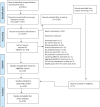Global Prevalence and Mental Health Outcomes of Intimate Partner Violence Among Women: A Systematic Review and Meta-Analysis
- PMID: 36825800
- PMCID: PMC10666489
- DOI: 10.1177/15248380231155529
Global Prevalence and Mental Health Outcomes of Intimate Partner Violence Among Women: A Systematic Review and Meta-Analysis
Abstract
The aim of this systematic review was to assess the magnitude of the association between types of intimate partner violence (IPV) and mental health outcomes and shed light on the large variation in IPV prevalence rates between low- to middle-income countries and high-income countries. The study is a systematic review and meta-analysis. The following databases were searched for this study: Cochrane, MEDLINE, EMBASE, PsycINFO, Cumulative Index to Nursing and Allied Health Literature, and the Applied Social Sciences Index and Abstracts. The inclusion criteria for this study are as follows: quantitative studies published from 2012 to 2020 on IPV exposure in women aged 16+, using validated measures. Random effects meta-analyses and subgroup analysis exploring heterogeneity across population groups in different economic contexts are used in this study. In all, 201 studies were included with 250,599 women, primarily from high-income countries. Higher prevalence rates were reported for women's lifetime IPV than past year IPV. Lifetime psychological violence was the most prevalent form of IPV. Women in the community reported the highest prevalence for physical, psychological, and sexual violence in the past year compared to clinical groups. Perinatal women were most likely to have experienced lifetime physical IPV. Prevalence rates differed significantly (p = .037 to <.001) for "any IPV" and all subtypes by income country level. Meta-analysis suggested increased odds for all mental health outcomes associated with IPV including depression (odds ratio [OR] = 2.04-3.14), posttraumatic stress disorder (PTSD) (OR = 2.15-2.66), and suicidality (OR = 2.17-5.52). Clinical and community populations were exposed to high prevalence of IPV and increased likelihood of depression, PTSD, and suicidality. Future research should seek to understand women's perspectives on service/support responses to IPV to address their mental health needs. Work with IPV survivors should be carried out to develop bespoke services to reduce IPV in groups most at risk such as pregnant and/or help-seeking women.
Keywords: battered women; cultural contexts; domestic violence; domestic violence and cultural contexts; mental health and violence; violence exposure.
Conflict of interest statement
Declaration of Conflicting InterestsThe author(s) declared no potential conflicts of interest with respect to the research, authorship, and/or publication of this article.
Figures




Comment in
-
The association between intimate partner violence type and mental health in migrant women living in Spain: findings from a cross-sectional study.Front Public Health. 2023 Dec 7;11:1307841. doi: 10.3389/fpubh.2023.1307841. eCollection 2023. Front Public Health. 2023. PMID: 38145064 Free PMC article.
References
-
- *Ahmadabadi Z., Najman J. M., Williams G. M., Clavarino A. M., d’Abbs P., Tran N. (2020). Intimate partner violence and subsequent depression and anxiety disorders. Social Psychiatry and Psychiatric Epidemiology, 55(5), 611–620. - PubMed
-
- Alangea O. D., Addo-Lartey A. A., Sikweyiya Y., Chirwa E. D., Coker-Appiah D., Jewkes R., Adanu R. M. K. (2018). Prevalence and risk factors of intimate partner violence among women in four districts of the central region of Ghana: Baseline findings from a cluster randomised controlled trial. PLoS One, 13(7), e0200874. - PMC - PubMed
-
- Al-Modallal H. (2016). Effect of intimate partner violence on health of women of Palestinian origin. International Nursing Review, 63(2), 259–266. - PubMed
-
- Baker D. E., Hill M., Chamberlain K., Hurd L., Karlsson M., Zielinski M., Calvert M., Bridges A. J. (2021). Interpersonal vs. Non-Interpersonal cumulative traumas and psychiatric symptoms in treatment-seeking incarcerated women. Journal of Trauma and Dissociation, 22(3), 249–264. - PubMed
Publication types
MeSH terms
Grants and funding
LinkOut - more resources
Full Text Sources
Medical
Miscellaneous

